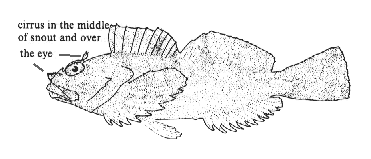Family: Cottidae (Sculpins)
Genus and Species:Scorpaenichthys marmoratus
Description: The body of the cabezon is elongate and stout. The head is large, broad and the snout is bluntly rounded. The mouth is large. The color is usually dark brown, but a variety of colors ranging from blue green to reddish brown occur and there is much mottling. It looks somewhat like the lingcod, and sometimes has blue colored flesh. It is a member of the true sculpin family and it can best be distinguished from the similar looking lingcod by: the absence of scales on its body; and by the presence of a small flap of skin, a cirrus, over each eye and in the middle of the snout. The lining of its mouth is a pale to dark blue and it also lacks the large teeth of the lingcod.
Range: Cabezon occur from Point Abreojos, Baja California, to Sitka, Alaska. Cabezon are usually found on the bottom around rocky reefs and kelp beds in water less than 120 feet deep, although they are known to occur as deep as 300 feet.
Natural History: The cabezon’s diet is made up of about 50 percent crabs and 50 percent mollusks and fishes. Small abalones are swallowed whole and the shells are regurgitated after some digestion takes place. These shells are sometimes beautifully polished by the action of the acids. Male cabezon first mature when about 2 years old and 12 inches long, females when 2 1/2 years old and 16 inches long. Females grow faster and attain larger sizes than do males. Spawning takes place from November through March, peaking in January. The adults tend to congregate at nesting sites. The eggs are laid in large masses on cleared rocks. The individual nest is guarded by the male who will drive away any intruder. A 5 pound female will lay an average of 66,000 eggs and a 23 pound female, 152,000. The eggs and young are free floating, some having been taken more than 200 miles from shore. The young enter the tide pools and inshore areas during the spring when they are about 1.5 inches long. They then lose their silvery color and take on the pattern characteristic of adults.
Fishing Information: Cabezon are caught by rocky shore anglers in every suitable area throughout the state. Larger numbers are caught in the central and northern part of the state. They are one of the most sought-after rocky shore inhabitants. Suitable baits include mussels, clams, squid, shrimp, worms, cut or strip bait, and live bait when available. Here again is a bottom rock dweller that can be most difficult to land if allowed to retreat to the shelter of rocks or seaweeds after being hooked. Cabezon eggs are poisonous, so do not eat the roe. Consumption of cabezon roe has produced near fatal results in humans.
Other Common Names: bullhead, cab, cabby, bull cod, giant sculpin, scorpion, marble sculpin.
Largest Recorded: 39 inches; 25 pounds.
Habitat: Shallow Rocky Environment
 Save Newport Real News in Newport Beach
Save Newport Real News in Newport Beach



